
Nov . 05, 2024 17:00 Back to list
how to dissolve hydroxyethyl cellulose
How to Dissolve Hydroxyethyl Cellulose
Hydroxyethyl cellulose (HEC) is a non-ionic, water-soluble polymer derived from cellulose. It is widely used in various industries, including pharmaceuticals, cosmetics, food products, and construction materials, due to its thickening, gelling, and emulsifying properties. However, dissolving HEC can be a bit tricky if proper techniques aren’t employed. This article provides a comprehensive guide on how to dissolve hydroxyethyl cellulose effectively.
Understanding Hydroxyethyl Cellulose
Before diving into the dissolution process, it’s essential to understand what hydroxyethyl cellulose is and its properties. HEC is a white, odorless powder that can absorb water and swell, forming a viscous solution. Its solubility is influenced by factors like temperature, pH, and concentration. When attempting to dissolve HEC, the goal is to create a uniform solution without clumps or undissolved particles.
Materials Needed
To dissolve hydroxyethyl cellulose, you will need the following materials
- Hydroxyethyl cellulose powder - Distilled water (or other suitable solvents) - A mixing vessel (preferably one with a lid) - A mechanical stirrer or hand whisk - A thermometer (optional)
Step-by-Step Guide for Dissolution
1. Choose the Right Water Temperature The temperature of the water plays a critical role in dissolving HEC. For best results, use warm water (about 60-70°C). Heating the water reduces the viscosity of the solution and allows HEC to hydrate more quickly. However, make sure the water is not boiling, as high temperatures can degrade the polymer.
2. Measure the HEC and Water The amount of hydroxyethyl cellulose you use will depend on your desired final viscosity. A common starting point is to use a concentration of 0.5% to 2% (w/v) HEC in water. For example, to make a 1% solution, you would need 1 gram of HEC for every 100 mL of water.
how to dissolve hydroxyethyl cellulose

3. Add HEC to Water Slowly sprinkle the HEC powder into the warm water while continuously stirring. It’s crucial to add the powder gradually to prevent clumping. If you add too much at once, the particles can clump together, making it challenging to achieve a uniform solution.
4. Stir Well Use a mechanical stirrer or hand whisk to mix the solution thoroughly. Stirring is essential for breaking up any clumps and ensuring that the HEC particles are evenly distributed. If using a mechanical stirrer, set it to a moderate speed to avoid creating too many air bubbles in the solution.
5. Allow Hydration Once the HEC is fully incorporated, allow the mixture to sit for a period—typically 15 to 30 minutes. This standing time enables the HEC to swell and hydrate fully, which contributes to its thickening properties.
6. Adjust Viscosity (if necessary) After the hydration period, evaluate the solution’s viscosity. If it’s too thick, you can gradually add more water while stirring until you achieve the desired consistency. Conversely, if you want a thicker solution, you can add more HEC, but make sure to repeat the stirring and hydration steps.
7. Cooling Down If you heated the water, let the solution cool down to room temperature. This cooling process can help stabilize the HEC solution, making it easier to handle and apply in various applications.
Troubleshooting Tips
- Clumping Issues If you notice clumps in your solution, it could be due to adding HEC too quickly. Always sprinkle it gradually and stir diligently. - Temperature Control Avoid using boiling water, as excessive heat can lead to the breakdown of HEC. - pH Sensitivity While HEC is generally stable over a wide range of pH levels, it’s good to check pH if it is to be used in sensitive formulations.
Conclusion
Dissolving hydroxyethyl cellulose can be a straightforward process when proper techniques are followed. By using the right temperature, gradually adding the powder, and stirring well, you can create a smooth, viscous solution that meets your needs. With these guidelines, you’ll be well-equipped to leverage the benefits of HEC in your formulations, whether for industrial use or personal projects. Happy mixing!
-
Versatile Hpmc Uses in Different Industries
NewsJun.19,2025
-
Redispersible Powder's Role in Enhancing Durability of Construction Products
NewsJun.19,2025
-
Hydroxyethyl Cellulose Applications Driving Green Industrial Processes
NewsJun.19,2025
-
Exploring Different Redispersible Polymer Powder
NewsJun.19,2025
-
Choosing the Right Mortar Bonding Agent
NewsJun.19,2025
-
Applications and Significance of China Hpmc in Modern Industries
NewsJun.19,2025







